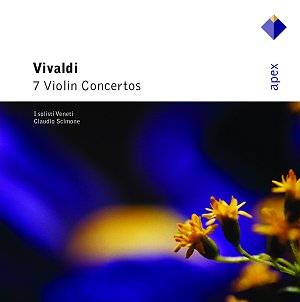A special composer who is always identifiable
but never predictable. I never cease to be amazed by Vivaldi's
innate gift for invention, colour and melody and his violin concertos
bear testament to this. On this release Apex have compiled seven
concertos for violin, strings and basso continuo from their back
Erato catalogue. The first five concertos appear to come from
a 1980 release which was themed to included a selection of violin
concertos to which Vivaldi had given descriptive titles. The final
two violin concertos were contained on a 1984 release; one of
which bears the title L’inquietudine’ and strangely the
other selected concerto is untitled and scored not for one but
for four violins, strings and harpsichord.
Vivaldi was a most prolific composer and according
to my latest works list he composed a massive 639 instrumental
scores; the vast majority featuring a solo instrumental part.
In fact, as many as 253 were composed for solo violin, string
orchestra and basso continuo; which was clearly his favoured instrumentation.
It should be borne in mind that the titles that Vivaldi gave,
or were given by others, to his works often only indicate the
general atmosphere rather than a strict programmatic intention
such as in ’The Four Seasons’.
All the violin concertos featured on this release
are composed in Vivaldi’s favoured three movement Allegro-Adagio-Allegro
structure. There is however a discernible contrast across the
selected concertos, which vary subtly in weight and technical
complexity. They give an excellent cross-section of Vivaldi’s
compositional expertise, aptly displaying his ability to combine
virtuosity and expression.
Of the six violin concertos here featuring the
solo violin the duties are shared by two soloists: the experienced
and often recorded Piero Toso and Marco Fornaciari, about whom
I know very little. There is little to choose between the performances
of both soloists who play with equal enthusiasm displaying a consistently
fine tone throughout. With regard to the concerto for four violins
RV 553, annoyingly the booklet notes only state who three of the
soloists are, presumably the fourth player is Marco Fornaciari.
I have several other recordings that feature
the ensemble I Solisti Veneti under the skilled direction of Claudio
Scimone. They are consistently impressive in this late-baroque
repertoire in which they specialise. Ensembles such as I Solisti
Veneti and Canadian based I Musici using modern instruments and
the Academy of Ancient Music and The English Concert on period
instruments were the first generation then at the cutting-edge
of Vivaldi performances some twenty or so years ago. However our
knowledge of Vivaldi and other early composers has increased and
performers have become vastly more proficient in performing technique
and style, exploiting the strengths of their period instruments
as opposed to being restricted by their weaknesses. Consequently
I feel ensembles such as I Solisti Veneti cannot now compete equally
on disc with the current new crop of Vivaldi performers.
Overall I favour my Vivaldi played with more
instrumental colour, richer sonorities and greater expression
as achieved by the new-generation ‘period instrument’ ensembles
namely: the Venice Baroque Orchestra with violin soloist Giuliano
Carmignola under Andrea Marcon, on Virgin Veritas, Europa Galante
under Fabio Biondi, on Sony Classical, the Ensemble Explorations
under Roel Dieltiens, on Harmonia Mundi, the Freiburger Barockorchester
under Gottfried von Der Goltz, on Opus 111 and the Concerto Italiano
under Rinaldo Alessandrini, on Naïve.
The booklet notes from Apex appear to originate
from the 1980 release and only contain information relating to
the first five concertos. There is no description of the concertos
in D major RV 234 and B flat major RV 553, which is a shame as
there is no excuse for booklet notes being anything other than
comprehensive.
Overall the warm recorded sound is acceptable,
although the first five concertos recorded in 1979 in ADD are
slightly cloudy, especially in the forte sections of the
ritornellos and are not as successful as the two later
concertos recorded digitally in 1983. To have increased the instrumental
colouring I would have preferred a sharper focused sound. Furthermore
the single discreet harpsichord accompaniment does not I feel
provide a sufficiently prominent and rich basso continuo.
Anyone looking for a cross-section of Vivaldi’s
violin concertos using modern instruments may feel satisfied with
this Apex release however there are many exciting newer recordings
available that are guaranteed to please.
Michael Cookson
